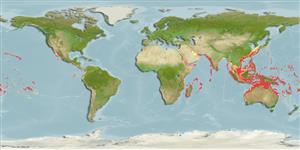>
Acanthuriformes (Surgeonfishes) >
Chaetodontidae (Butterflyfishes)
Etymology: Forcipiger: Latin, forceps = instrument of the pincers kind used for seizing and holding objects, esp. In surgical and obstetric operations + latin, gero = to carry; 1634 (Ref. 45335).
More on authors: Jordan & McGregor.
Issue
FishBase common name changed from Longnose butterfly[ ]fish FAO/ASFIS: Ref. 131312 ) to Forcepsfish (AFS: Ref. 130874) because it is used forForcipiger longirostris (and longirostris = long nose).
Environment: milieu / climate zone / depth range / distribution range
Sinh thái học
Biển Cùng sống ở rạn san hô; không di cư; Mức độ sâu 0 - 145 m (Ref. 89467). Tropical; 36°N - 32°S, 30°E - 79°W
Indo-Pacific: Red Sea and East Africa (Ref. 12484) to the Hawaiian and Easter islands, north to southern Japan, south to Lord Howe Island; throughout Micronesia. Eastern Pacific: southern Baja California, Mexico and from the Revillagigedo and Galapagos Islands (Ref. 5227, 11482).
Bộ gần gũi / Khối lượng (Trọng lượng) / Age
Maturity: Lm ? range ? - ? cm
Max length : 22.0 cm TL con đực/không giới tính; (Ref. 9710); Tuổi cực đại được báo cáo: 18 các năm (Ref. 72479)
Các tia vây lưng cứng (tổng cộng) : 12 - 13; Các vây lưng mềm (tổng cộng) : 19 - 25; Tia cứng vây hậu môn: 3; Tia mềm vây hậu môn: 17 - 19.
Common in exposed seaward reefs but also found in lagoon reefs (Ref. 9286). Benthopelagic (Ref. 58302). Solitary or in small groups of up to 5 individuals (Ref. 9286). Adults usually in pairs (Ref. 48636). Feed on a wide variety of animal prey including hydroids, fish eggs, small crustaceans but prefers tube feet of echinoderms, pedicilaria of sea urchins, and polychaete tentacles (Ref. 1602). Oviparous (Ref. 205), monogamous (Ref. 52884). Form pairs during breeding (Ref. 205). Second most important export in Hawaii (Ref. 37816). Minimum depth reported taken from Ref. 128797.
Life cycle and mating behavior
Chín muồi sinh dục | Sự tái sinh sản | Đẻ trứng | Các trứng | Sự sinh sản | Ấu trùng
Distinct pairing (Ref. 205). Monogamous mating is observed as both obligate and social (Ref. 52884).
Myers, R.F., 1991. Micronesian reef fishes. Second Ed. Coral Graphics, Barrigada, Guam. 298 p. (Ref. 1602)
IUCN Red List Status (Ref. 130435: Version 2024-1)
Threat to humans
Harmless
Human uses
Các nghề cá: không ích lợi (thú vị); Bể nuôi cá: Tính thương mại
Các công cụ
Special reports
Download XML
Các nguồn internet
Estimates based on models
Preferred temperature (Ref.
123201): 24.3 - 28.8, mean 27.5 °C (based on 710 cells).
Phylogenetic diversity index (Ref.
82804): PD
50 = 0.6250 [Uniqueness, from 0.5 = low to 2.0 = high].
Bayesian length-weight: a=0.01995 (0.00906 - 0.04395), b=3.01 (2.83 - 3.19), in cm total length, based on all LWR estimates for this body shape (Ref.
93245).
Mức dinh dưỡng (Ref.
69278): 3.1 ±0.2 se; based on diet studies.
Thích nghi nhanh (Ref.
120179): Chiêù cao, thời gian nhân đôi của chủng quần tối thiểu là dưới 15 tháng (Preliminary K or Fecundity.).
Fishing Vulnerability (Ref.
59153): Low vulnerability (12 of 100).
Nutrients (Ref.
124155): Calcium = 77.3 [40.2, 116.8] mg/100g; Iron = 0.735 [0.446, 1.180] mg/100g; Protein = 18.5 [17.4, 19.7] %; Omega3 = 0.129 [0.079, 0.208] g/100g; Selenium = 44.4 [24.8, 80.8] μg/100g; VitaminA = 44.4 [12.5, 154.3] μg/100g; Zinc = 1.25 [0.86, 1.79] mg/100g (wet weight);
